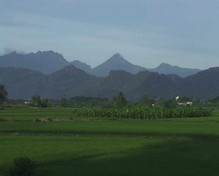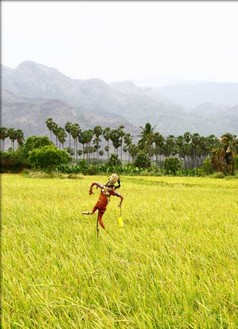Agasthya
A newsletter on the Natural History, Ecology
and Conservation of the Agasthyamalai region, Western Ghats, India.
ASHOKA TRUST FOR RESEARCH IN ECOLOGY AND THE ENVIRONMENT
Centre for Excellence in Conservation Science
Royal Enclave,Srirampura,Jakkur Post
Bangalore-560064
Telephone: 080-23635555 (EPABX)
Fax : 080- 23530070
Any and all opinions expressed in this newsletter are solely those of the author(s) and do not reflect the opinion of ATREE.
Editorial Team
Editor: T. Ganesh
Associate editor: Vivek Ramachandran
Editorial Review: R. Ganesan, M. Soubadra Devy
Design and presentation: Vivek Ramachandran
A S H O K A T R U S T F O R R E S E A R C H I N E C O L O G Y A N D T H E E N V I R O N M E N T
'The feared and revered'- farmers perception on snakes
- Wendy Kapadia Barreto
Paddy fields abutting the reserve
Photo- Wendy
'The feared and revered' have been a most fascinating topic for many people over the years. The behaviour of snakes has been luring me for over 3 years now and I could not quite understand it. The thing I love most about them is their behavior. It can become so predictable with time. They never bite unless agitated and more than 50% of the time they are dry bites. It was not until I was educated on their behavior and varied species and until I held one in my hands that I felt the need to do something about this highly misunderstood species. So I decided to do a project in order to find out some facts on the usefulness of snakes and how we can try and make the farmers see a bigger role for them in the ecosystem.
Only four indirect signs of snakes were encountered while surveying the paddy fields. The interviews with farmers were useful as it found that most farmers showed a positive attitude towards snakes, agreeing that they were of use in the fields, however all of them believed that it is an insufficient and non convincing argument that they are an effective method of pest control. The visit to the hospital proved very interesting in many ways. The numbers showed that though there was a relatively low percentage of snake bite in the area most of them were from water snakes, showing that the people's identification of snakes was not very accurate. Venomous snake bite was a rare occurrence and the death rate was extremely low, only 2 over the last eight years.
This project and the course on the whole have been most enlightening. I got the opportunity to study something that I have been intrigued about for years and the chance to understand the perceptions of farmers in this area, a small attempt at taking a peep into the trials of their daily lives.. I have now seen a small bit of the bigger picture and all the factors affecting our major ecosystems and what areas need to be addressed when looking at conservation through an objective lens.








